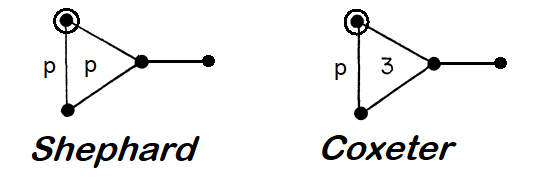(γp4)/p
- general polytopal classes:
- complex polytopes
links

| Acronym | ... |
| Name |
complex polychoron sp-4-o2-3-o2-3-o2, (γp4)/p |
| Coordinates | (εpn, εpm, εpk, εpl) for any 1≤n,m,k,l≤p, where εp=exp(2πi/p) and n+m+k+l ≡ 0 mod(p) |
| Face vector | p3, 6p3, 2p2(2p+3), p(p2+4) |
| Confer |
|
|
External links |

|
This is the snub when being applied onto xp-4-o2-3-o2-3-o2, the coordinates of which there had been given as (εpn, εpm, εpk, εpl) for any 1≤n,m,k,l≤p, where εp=exp(2πi/p). Here now the pre-image of th sp node consists of a p-edge. None the less an according alternation is still possible, but then it is no longer one out of two, rather it is selecting (locally!) one out of p instead. In fact, this afore mentioned quest amounts in a further relation on those possible exponents of the coordinates: n+m+k+l ≡ 0 mod(p).
The total edge count could be derived from the edge count per vertex. To that purpose one observes that the new vertex-incident edges here just are aligned as diagonals of the vertex-incident squares of the real hypercube, the pre-image is a generalizing of. Thus this number generally is given simply as 2 choose(D, 2), where D is the according dimensionality of that real space hypercube. Alternatively it turns out to be derivable simply as the total edge count of those sp-4-o2 faces.
The count of the former vertex figures, here coming in as sectioning facets underneath, at first sight would have the former vertex count. However, like the vertices themselves, these sefas too fall into p modulo classes, i.e. forming a compound. Just a single thereof will be supported by the selected vertices. Thence the count of those is 1/p of the former vertex count.
In fact, it even is that "almost regular" complex polychoron, which C.G. Shephard and H.S.M. Coxeter denoted respectively by:

However note, as this complex polychoron implements a further almost regular polytope ( (γp3)/p ) as some of its facets, so be aware of what had been told there already about their complex "non-closing" behaviour.
Incidence matrix according to Dynkin symbol
sp-4-o2-3-o2-3-o2
p-th( . . . . ) | p3 | 12 | 6 12 | 4 4
-------------------------+----+-----+---------+-------
edge( sp-4-o2 . . ) | 2 | 6p3 | 1 2 | 2 1
-------------------------+----+-----+---------+-------
sp-4-o2 . . ♦ p | p | 6p2 * | 2 0
sefa( sp-4-o2-3-o2 . ) | 3 | 3 | * 4p3 | 1 1
-------------------------+----+-----+---------+-------
sp-4-o2-3-o2 . ♦ p2 | 3p2 | 3p p2 | 4p *
sefa( sp-4-o2-3-o2-3-o2 ) ♦ 4 | 6 | 0 4 | * p3
starting figure: xp-4-o2-3-o2-3-o2
© 2004-2025 | top of page |